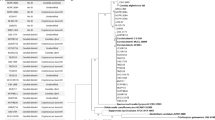Abstract
Organisms that form an essential extra inner lining of selected areas of the stomach mucosa occur in mice, rats and some other animals. The yeast Cyniclomyces guttulatus (Saccharomycopsis guttulata) was shown in this study to line the stomach of domestic and feral rabbits, guinea pigs, and chinchillas. The layer of yeast cells formed a loose barrier between lumen contents and mucosal surface. A rapid rate of multiplication in the stomach provided yeast cells that blended in with stomach lumen contents, passed throught the gut, and were finally excreted in large numbers in fecal pellets. Ascospore formation occurred during passage through the large intestine. The layer of yeast cells lining the stomach had no evident salubrious nor deleterious effect on the animal. C. guttulatus grew rapidly from stomach contents or single fecal pellets in a new enriched semisolid medium. Growth was good at pH 1 through 8 on the solidified enriched medium. A very unusual characteristic of C. guttulatus is optimal growht at 38° C, and growth at 42° C, with failure to grow below 30° C. TEM demonstrated a very thick, laminated cell wall which had a thick, filamentous external coating. There were mitochondria, polyribosomes, lipid droplets, and an unusually large central nucleus. The developing spore nucleus became extremely electron dense and encapsulated, along with condensed mitochondria, ribosomes, short membrane sections and other organelles, in a dense lamellar covering.
Similar content being viewed by others
References
Horakova, Z, Zierdt, CH & Beaver, MA (1971) Identification of Lactobacillus as the scource of bacterial histidine decarboxylase in rat stomach. European J. Pharmacology 16: 67–77
Lodder, J & Kreger-van Rij, NJW (1952) The Yeasts. A Taxomonic Study. North Holland Publishing Co., Amsterdam
Parle, JN (1956) The growth of Saccharomcopsis guttulata. Ant. van Leeuwenhoek 22: 237–242
Richle, R & Scholer, HJ (1961) Saccharomycopsis guttulata von kaninchen: Kulturelle Eigenschaften und mögliche Bedeutung. Path. Microbiol. 24: 783–793
Shifrine, M & Phaff, HJ (1958) On the isolation, ecology, and taxomony of Saccharomycopsis guttulata. Ant. van Leeuwenhoek 24: 193–209
Walt, JPVan der & Scott, DB (1971) The yeast genus Saccharomycopsis Schiönning. Mycopathol. Mycol. Appl. 43: 279–288
Wilhelmi, A (1898) Beitrage zur Kenntnis des Saccharomyces guttulatus. Z. Bakt. Parasitenk. Band II. abt 4: 305, 353, 412
Author information
Authors and Affiliations
Rights and permissions
About this article
Cite this article
Zierdt, C.H., Detlefson, C., Muller, J. et al. Cyniclomyces guttulatus (Saccharomycopsis guttulata) — culture, ultrastructure and physiology. Antonie van Leeuwenhoek 54, 357–366 (1988). https://doi.org/10.1007/BF00393526
Received:
Accepted:
Issue Date:
DOI: https://doi.org/10.1007/BF00393526




